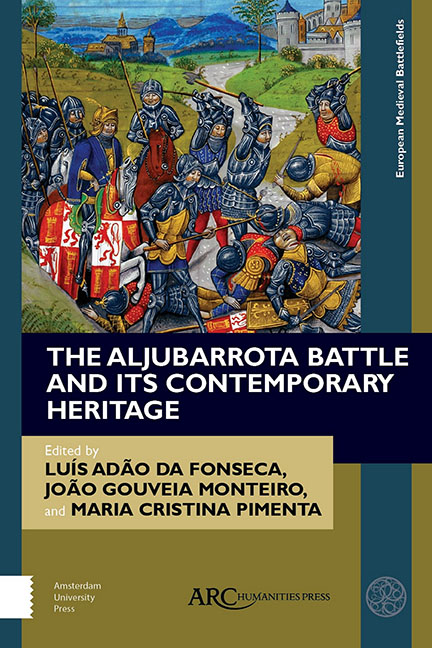Book contents
- Frontmatter
- Contents
- List of Illustrations
- Introduction
- Chapter 1 Before Aljubarrota
- Chapter 2 Fighting a Battle in the Middle Ages
- Chapter 3 The Decision to Fight at Aljubarrota
- Chapter 4 The Decisive Battle
- Chapter 5 Casualties and the Aftermath
- Chapter 6 Contemporary Memory and Myth-Making
- Chapter 7 The Legacy for Later Memories
- Chapter 8 The Battle of Aljubarrota Interpretation Centres
- Select Bibliography
- Index
Chapter 8 - The Battle of Aljubarrota Interpretation Centres
Published online by Cambridge University Press: 20 November 2020
- Frontmatter
- Contents
- List of Illustrations
- Introduction
- Chapter 1 Before Aljubarrota
- Chapter 2 Fighting a Battle in the Middle Ages
- Chapter 3 The Decision to Fight at Aljubarrota
- Chapter 4 The Decisive Battle
- Chapter 5 Casualties and the Aftermath
- Chapter 6 Contemporary Memory and Myth-Making
- Chapter 7 The Legacy for Later Memories
- Chapter 8 The Battle of Aljubarrota Interpretation Centres
- Select Bibliography
- Index
Summary
AS WITH MOST European countries, the creation of Portugal as an independent nation only became possible through victories in several decisive battles that took place mainly in the thirteenth, fourteenth, and fifteenth centuries. This is the period in which many European countries were formed.
Although in the course of eight hundred years of Portuguese history several military confrontations took place within its territory, it is possible to identify several battles that were decisive in its creation and consolidation as an independent country.
The battles held during the War of Independence (1383–1411) and the War of Restoration (1640–1668) were particularly important to the political process that resulted in Portugal's independence. This is why over the years, particularly since the beginning of the twentieth century, initiatives have been taken to identify and protect these battlefields. These battlefields had remained mostly abandoned and with no effective administrative protection, which had allowed, over time, the landscape to be damaged. These incursions included roads built over historical sites, inappropriate commercial use of parts of the landscape, and the construction of various buildings and houses on the battlefields.
This lack of recognition of the non-material value of key battlefields was common until relatively recently. In fact, major battlefields in Europe and North America began only to be visited by the public in the second half of the twentieth century, particularly from the 1970s.
In Portugal, the first administrative measure to protect a battlefield was taken in 1977, when a small part of the battlefield of Aljubarrota began to be managed by the Ministry of Culture. Then, in 1985, the Portuguese government built a small military museum on the battlefield that began to receive approximately five thousand visitors per year. All other battlefields remained without any cultural protection.
Creation of the Battle of Aljubarrota Foundation
Although public opinion generally considered that the battlefield of Aljubarrota should be improved and developed, since this was the most important battle in the history of Portugal, this historical site remained, until 2001, to a great extent without legal protection and undervalued.
- Type
- Chapter
- Information
- Aljubarrota Battle and Its Contemporary Heritage , pp. 113 - 120Publisher: Amsterdam University PressPrint publication year: 2020



